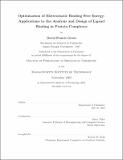Optimization of electrostatic binding free energy : applications to the analysis and design of ligand binding in protein complexes
Author(s)
Green, David Francis, 1975-
DownloadFull printable version (1.858Mb)
Other Contributors
Massachusetts Institute of Technology. Dept. of Chemistry.
Advisor
Bruce Tidor.
Terms of use
Metadata
Show full item recordAbstract
Electrostatic interactions play an important role in determining the energetics of association in biomolecular complexes. Previous work has shown that, within a continuum electrostatic model, for any given complex there exists a ligand charge distribution which optimizes the electrostatic binding free energy - the electrostatic complement of the target receptor. This electrostatic affinity optimization procedure was applied to several systems both in order to understand the role of electrostatic interactions in natural systems and as a tool in the design of ligands with improved affinity. Comparison of the natural and optimal charges of several ligands of glutaminyl-tRNA synthetase from E. coli, an enzyme with a strong natural requirement for specificity, shows remarkable similarity in many areas, suggesting that the optimization of electrostatic interactions played a role in the evolution of this system. The optimization procedure was also applied to the design of improvements to two inhibitors of HIV-1 viral-cell membrane fusion. Two tryptophan residues that are part of a D-peptide inhibitor were identified as contributing most significantly to binding, and a novel computational screening procedure based on the optimization methodology was developed to screen a library of tryptophan derivatives at both positions. Additionally, the optimization methodology was used to predict four mutations to standard amino acids at three positions on 5-Helix, a protein inhibitor of membrane fusion. All mutations were computed to improve the affinity of the inhibitor, with a five hundred-fold improvement calculated for one triple mutant. (cont.) In the complex of b-lactamase inhibitor protein with TEM1 b-lactamase, a novel type of electrostatic interaction was identified, with surface exposed charged groups on the periphery of the binding interface projecting significant energetic effects through as much as 10 A of solvent. Finally, a large number of ab initio methods for determining partial atomic charges on small molecules were evaluated in terms of their ability to reproduce experimental values in continuum electrostatic calculations, with several preferred methods identified.
Description
Thesis (Ph. D.)--Massachusetts Institute of Technology, Dept. of Chemistry, 2002. Vita. Includes bibliographical references (p. 279-298). This electronic version was submitted by the student author. The certified thesis is available in the Institute Archives and Special Collections.
Date issued
2002Department
Massachusetts Institute of Technology. Department of ChemistryPublisher
Massachusetts Institute of Technology
Keywords
Chemistry.